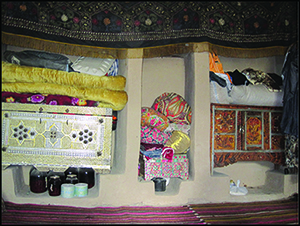Crossref Citations
This article has been cited by the following publications. This list is generated based on data provided by
Crossref.
Macphail, Richard I.
and
Goldberg, Paul
2018.
Interpretation of Micromorphological Features of Soils and Regoliths.
p.
779.
Shahack‐Gross, Ruth
Shaar, Ron
Hassul, Erez
Ebert, Yael
Forget, Mathilde
Nowaczyk, Norbert
Marco, Shmuel
Finkelstein, Israel
and
Agnon, Amotz
2018.
Fire and collapse: Untangling the formation of destruction layers using archaeomagnetism.
Geoarchaeology,
Vol. 33,
Issue. 5,
p.
513.
Jordanova, Neli
Jordanova, Diana
Kostadinova‐Avramova, Maria
Lesigyarski, Deyan
Nikolov, Vassil
Katsarov, Georgi
and
Bacvarov, Krum
2018.
A Mineral Magnetic Approach to Determine Paleo‐Firing Temperatures in the Neolithic Settlement Site of Mursalevo‐Deveboaz (SW Bulgaria).
Journal of Geophysical Research: Solid Earth,
Vol. 123,
Issue. 4,
p.
2522.
O’Grady, Caitlin R.
Luke, Christina
Mokrišová, Jana
Roosevelt, Christopher H.
and
Geraghty, Lincoln
2018.
Interdisciplinary approaches to understanding and preserving mudbrick architecture in regional and diachronic contexts.
Cogent Arts & Humanities,
Vol. 5,
Issue. 1,
Roussos, Dimitrios N.
and
Kyparissi‐Apostolika, Nina
2019.
An integrated geoarchaeological methodology to reveal site formation processes linked to building practices and pyrotechnology at Middle Neolithic Imvrou Pigadi, Greece.
Geoarchaeology,
Vol. 34,
Issue. 2,
p.
200.
Kreimerman, Igor
and
Shahack-Gross, Ruth
2019.
Understanding conflagration of one-story mud-brick structures: an experimental approach.
Archaeological and Anthropological Sciences,
Vol. 11,
Issue. 6,
p.
2911.
Kreimerman, Igor
Garfinkel, Yosef
Hasel, Michael G.
and
Shahack-Gross, Ruth
2022.
High-resolution investigation of a conflagration event in the North-East Temple at Lachish via integration of forensic, stratigraphic and geoarchaeological evidence: A model for studying architectural destruction by fire.
Journal of Archaeological Science: Reports,
Vol. 46,
Issue. ,
p.
103705.
Kalogiropoulou, Evita
Saridaki, Niki
Roussos, Dimitris
and
Kyparissi-Apostolika, Nina
2023.
Craftmanship, Operation, and the Configuration of Social Space: The Case of the Middle Neolithic Pottery Workshop Site of Imvrou Pigadi, Thessaly, Greece.
Journal of Field Archaeology,
Vol. 48,
Issue. 6,
p.
463.
Ortiz, Steven M.
2023.
“And in Length of Days Understanding” (Job 12:12).
p.
723.
Vaknin, Yoav
Shaar, Ron
Lipschits, Oded
Eliyahu Behar, Adi
Maeir, Aren M.
Ben-Yosef, Erez
and
Iovita, Radu
2023.
Applying thermal demagnetization to archaeological materials: A tool for detecting burnt clay and estimating its firing temperature.
PLOS ONE,
Vol. 18,
Issue. 10,
p.
e0289424.
Grono, Elle
Edrey, Meir
Morstadt, Bärbel
Bampton, Philip
Zuckerman-Cooper, Roni
Bermatov Paz, Gal
Langgut, Dafna
and
Friesem, David E.
2024.
Identifying construction technologies and environmental connections at the Iron Age IIA settlement of Kh. es-Suwweida, Israel: A microarchaeological study.
Journal of Archaeological Science: Reports,
Vol. 60,
Issue. ,
p.
104850.
Kleiman, Assaf
Hall, Erin
Kalisher, Rachel
Dunseth, Zachary C.
Sapir-Hen, Lidar
Homsher, Robert S.
Adams, Matthew J.
and
Finkelstein, Israel
2024.
Crisis in motion: the final days of Iron Age I Megiddo.
Levant,
Vol. 56,
Issue. 1,
p.
66.



